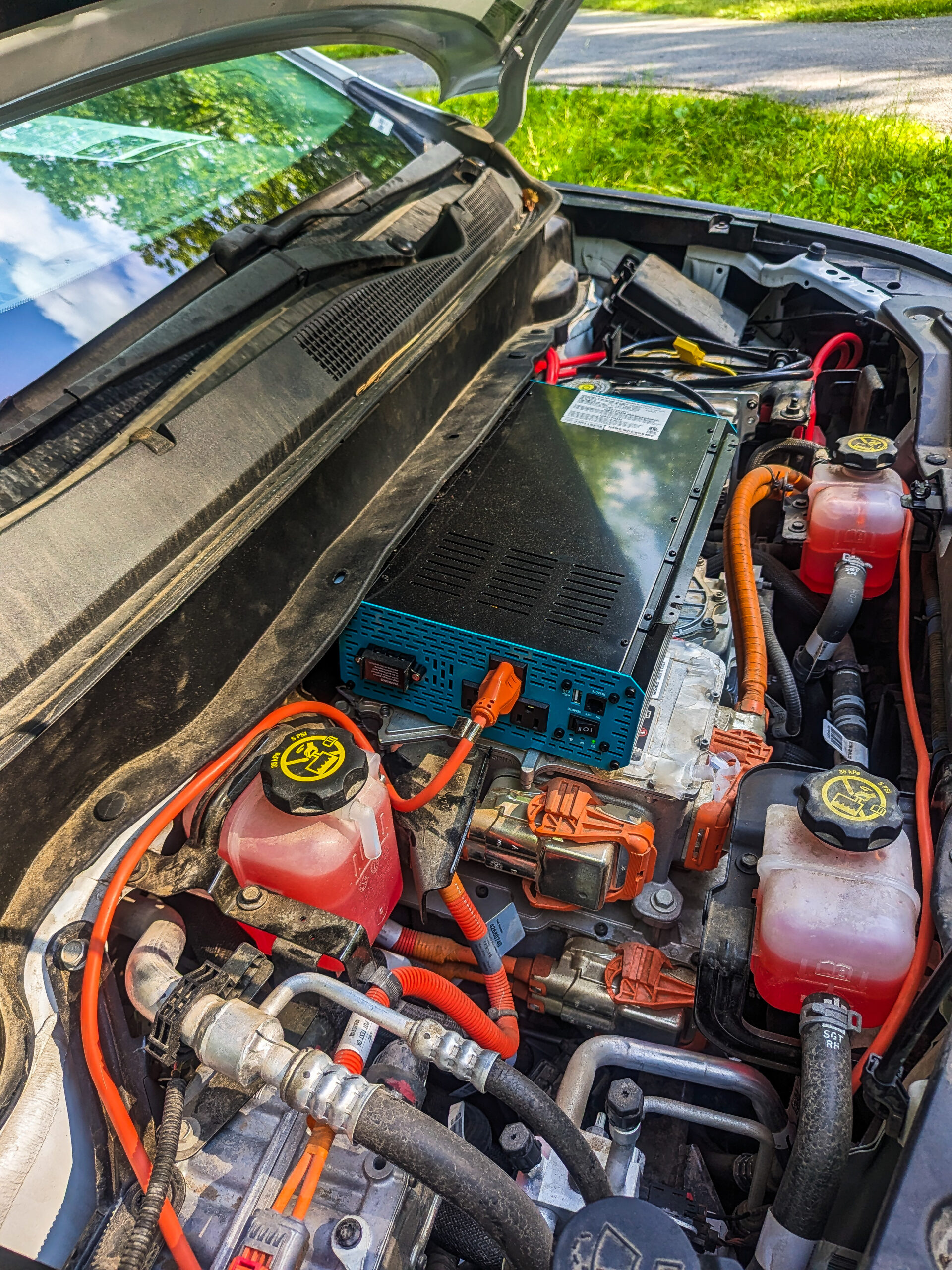Sign up for daily news updates from CleanTechnica on email. Or follow us on Google News!
In another recent article, I covered the challenges an Appalachian farmer overcame using solar power, battery power stations, and lots of ingenuity. Between a 1200 watt solar array, a slew of power stations he had been sent to review on his YouTube channel, 12-volt deep cycle batteries, extension cords, portable solar panels, “backfeeding” power into circuits, and ferrying power from a generator with power stations, he managed to keep all of his vital equipment running after over a week without power.
Since then, I came across an interesting ad from Bluetti on Facebook:
I’ve been in the process of reviewing a very similar product from EcoFlow that takes power from a vehicle’s 12-volt battery and uses it to rapidly charge power stations. This product is going to eventually replace another setup I currently have in my Chevy Bolt EUV. Before dedicated chargers came out to do this, I added my own 2000 watt inverter under the hood, ran an extension cord under the vehicle to the trailer hitch, and then used that to put about 1000 watts of power into a Jackery 3000 Pro. This, in turn, powered my whole campsite, kitchen, and even air conditioning with heat pump!
While I have a “pure” setup that converts the Bolt’s battery power to charge the 12-volt battery, which charges the Jackery, which acts as a buffer to power everything in and near the trailer, most people aren’t going to use a 12-volt “alternator charger” to get power from an EV to power their campsite, job site, or emergency needs. Because so many people are still driving gas and diesel-powered vehicles, especially out in the boonies, most buyers are going to be using the engine and alternator as a generator to charge power stations.
Despite the power ultimately coming from the engine, this still puts people ahead environmentally. Instead of running a dedicated generator at a campsite, overlanders and campers charging a power station as they drive end up using less fuel and burning that fuel in a more efficient and lower emissions engine than some largely unregulated generator. The power station can also power things that might otherwise be powered by propane, like a camp stove, lantern, and other things.
A More Important Advantage: Versatility
As I continue to improve my camping setup (LOTS more exciting detail on that coming in the next few weeks), I’m realizing that these portable power stations are becoming the omnivores of the cleantech world.
My power stations don’t too much care where the electricity comes from. One mounted in a trailer can charge from the vehicle while driving, charge from an outlet at an RV park, charge from solar panels (mounted on the trailer or folded out at a destination), and even charge in a hotel room if you’re willing to lug it inside and plug it in. You could also charge it using any fossil fuel with a generator, charge it from an internal combustion engine, or even use hydrogen if a hydrogen generator is available.
Once charged, you can power just about anything (assuming the generator has sufficient output for the task, of course). Charging other batteries, communication gear, and even EVs and e-bikes is possible, and there’s no way to make gasoline off-grid. Cooking, heating and cooling, cleaning, lighting, power tools, and anything else can all be powered from the right power station. You can easily run fridges and freezers, too.
In other words, you can use just about any source of energy to do anything, and you have options.
Resilience
All of this flexibility means something even more important when lives are on the line: the ability to fail gracefully and roll with the punches.
A robust system is good because it’s strong enough to “take a lickin’ and keep on tickin.’” But it’s almost never economically wise to build things so strong and so durable that it can resist the force of any and all imaginable emergencies. There are some hardened military systems that are built almost like that, but for things like power grids, nobody would be able to afford that level of unfailing service that they’re unlikely to need.
Instead of building things to be robust, it can be a lot more economical to build systems to be resilient. Having other options to fall back on is part of resilience. Having the ability to do without certain things and prioritize the most critical things is another. Adapting, improvising, and changing things to get the job done is another.
Power stations and many other forms of clean technology exemplify this. At the larger scales, things like solar farms in Ukraine quickly going back up (even if with less power) show that clean technology can fail more gracefully and come back faster to at least partially cover needs. At the smaller scale, you have these power stations of all sizes (some can fit in a larger pocket!) that can power anything from anything.
Making Resilience More Affordable Via Dual Use
Nobody wants to spend hundreds or thousands of dollars for emergencies. Something that sits in your closet and does nothing 99% of the time just makes it tough for people to want to lay the cash on the barrelhead. Heck, only a small percentage of the population has a dedicated three-day supply of food and water on hand for emergencies, so expecting people to go beyond that seems like a big ask.
However, items that are not needed just in emergencies are an easier pill to swallow. After all, something that’s useful as a tool around the house and useful on camping trips is easier to consider. Again, these devices’ ability to power anything from anything means that they can power work and play along with emergency needs. You don’t need a special power station for work, a special one for camping, and a special one to use after a hurricane. It’s all the same batteries, same charging, and same inverters to power things.
Final Thoughts
This, of course, applies broadly to many other areas of clean technology. An EV’s battery, for example, can be used to get around, help stabilize the power grid, power a campsite, power a house, and power many other things.
Relying on fossil fuels might seem like the quick and easy go-to solution for emergencies, outdoor activities, and many other things. But, when you need to adapt, change your plans, or use the little piece of kit for something else, you’re out of luck.
Featured image by Jennifer Sensiba.

Chip in a few dollars a month to help support independent cleantech coverage that helps to accelerate the cleantech revolution!
Have a tip for CleanTechnica? Want to advertise? Want to suggest a guest for our CleanTech Talk podcast? Contact us here.
CleanTechnica uses affiliate links. See our policy here.
CleanTechnica’s Comment Policy






